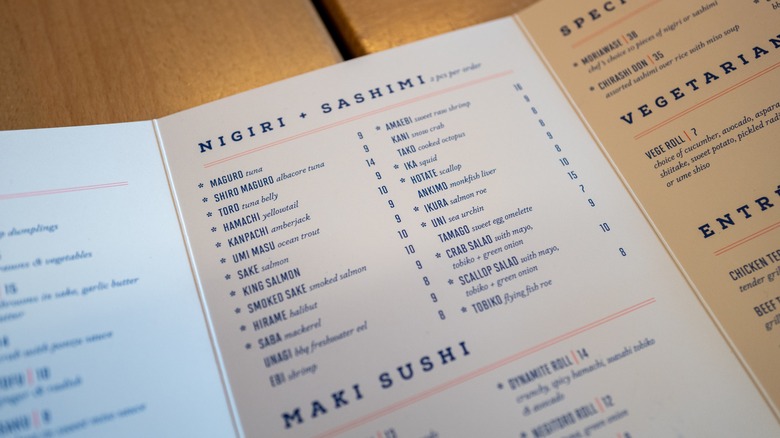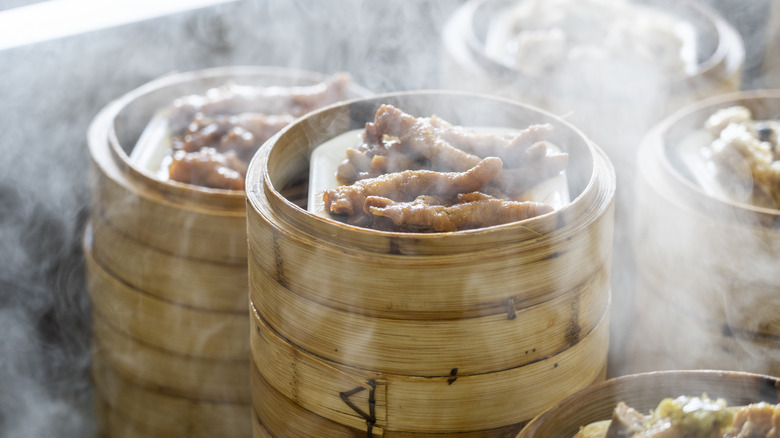The Restaurant Menu Red Flag That Should Send You Running
Say you're trying out a new restaurant that you saw on your social media feed. When you walk in, it's got everything nice going for it — cheerful staff, good ambiance, and a decent crowd. You settle down, and the server brings forth a dictionary-like menu that crashes onto a table with a dull thud. A bit terrified, you slog through pages of dishes that seem to come from all over the world. By the time you manage to pick one, it's already been 15 minutes.
It's a funny thought, but it's not without some truth to it — some restaurants really are like that. In case you ever run into such a spot in the future, trust us when say that it's better to pack up and walk out pronto. A giant menu is one equally sized red flag that you shouldn't ignore when picking a place to eat. Anthony Bourdain said it best in an interview with Money: "If they have a menu that's all over the place, if they have a hamburger or Asian fusion and it's not in Asia, these are all worrisome to me."
A concise menu is a hallmark of top restaurants
Take a look at the menus of Michelin-starred, fine-dining restaurants, and you'll notice a common thread — conciseness and simplicity. At Eleven Madison Park, for instance, the most you'll get is a single slip of paper that lists the day's course. Even for restaurants that serve à la carte, the menu is typically a thin booklet featuring no more than a dozen or so dishes that follow a cohesive theme, drinks included.
Speaking of themes, that's an important factor to consider too. When a restaurant's dishes are unified by a single cuisine or concept, the chef and kitchen staff are most likely well-taught in making such meals. As such, you can be more confident in the quality of the food. In contrast, if a restaurant advertises itself as French but features a section for Chinese fare halfway through the menu, we wouldn't blame you for feeling a little bit weirded out and discouraged from ordering.
If you often dine out, then you'll know that this rule doesn't just apply to high-scale restaurants. Any bistros or diners that serve good food won't ever hand you a bulky menu. So, if you ever find yourself at one that does, that's definitely a cause for alarm.
There are exceptions to the rule
It's worth noting that long menus aren't always bad. Certain places, like dim sum restaurants, have diverse menus due to the sheer variety of dishes they offer. In addition to dumplings, dim sum includes buns, rolls, and more. Unlike a French bistro that can feature a single course-of-the-day on a placard, these restaurants can't fit their entire selection on a small menu. As long as they adhere to the thematic rule mentioned earlier (only serving Chinese food), you'll likely have a good time eating there.
Plus, it's worth noting that many dim sum dishes share common techniques and ingredients. For instance, a steamed custard bun and a steamed pork bun, while they're technically different dishes, are made using the same steaming method and a basic dough ball. The same thing applies to spring rolls and egg rolls or different variations of siu mai. So, the restaurant's pantry doesn't have to stock too many different ingredients, ensuring freshness. Plus, the kitchen staff won't have to sweat too much to put out so many dishes at once either.
So, the consensus is this: Long menus are acceptable in certain places only, but it's definitely not the norm. Outside of places that are known to have a diverse menu, if a restaurant commits this faux pas, they're likely nothing good.


